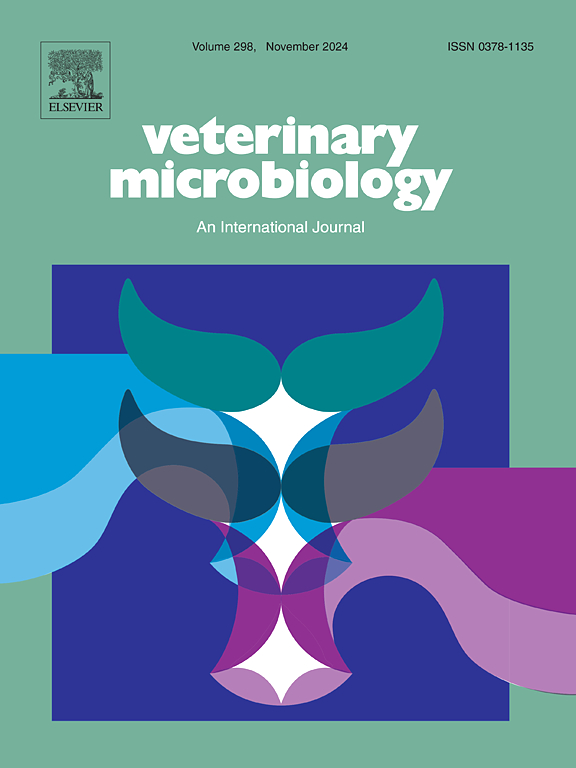在德国根除牛病毒性腹泻病毒:一个永无止境的成功故事还是仅仅是最后46只PI动物?
IF 2.7
2区 农林科学
Q3 MICROBIOLOGY
引用次数: 0
摘要
牛病毒性腹泻病毒(BVDV)是一种全球重要的牛病原体,可导致严重的繁殖失败、免疫抑制和经济损失。在德国,2011年启动了一项全国牛病毒性腹泻(BVD)控制规划,旨在通过系统检测和早期清除持续感染(PI)的动物来消除病毒,并在规划的早期阶段提供可选的疫苗接种、生物安全措施以及仅与经过认证的无可疑牛进行交易。到2024年,新生牛犊的PI患病率从2011年的0.473 %下降到0.001 %,每年检测的400多万头牛犊中只有46头被检测出PI。基于阳性样本5 '非翻译区测序的病毒分型确定BVDV-1d为大多数受影响联邦州的主要亚型,尽管各州之间的序列存在差异,而BVDV-1b仅限于石勒苏益格-荷尔斯泰因州。与公开获得的序列比较显示,在一些联邦州,与当地菌株的核苷酸一致性最高,而在其他州,有迹象表明病毒是从其他欧洲国家引入的。状态内序列同质性和状态间变异提示病毒传播受限和局部持久性。这些发现突出了德国BVDV根除战略的重大成功,导致99.994 %的BVDV无畜群,从而表明系统地识别和清除PI动物,结合监测和生物安全,可以将病毒流行率提高到接近消除的水平。持续的分子监测和对残余病例的快速反应对于防止再次出现和保障在全国根除BVDV方面取得的进展仍然至关重要。本文章由计算机程序翻译,如有差异,请以英文原文为准。
Bovine viral diarrhea virus eradication in Germany: A never-ending success story or just the last 46 PI animals?
Bovine viral diarrhea virus (BVDV) is a globally significant pathogen of cattle, causing significant reproductive failure, immunosuppression, and economic losses. In Germany, a national bovine viral diarrhea (BVD) control program was initiated in 2011, aiming to eliminate the virus through systematic testing and early removal of persistently infected (PI) animals, supported by optional vaccination in the early stage of the program, biosecurity measures, and trade with certified unsuspicious cattle only. By 2024, the PI prevalence among newborn calves had declined from 0.473 % in 2011 to just 0.001 %, with only 46 PI calves detected among over 4 million tested each year. Virus subtyping based on sequencing of the 5’ untranslated region of positive samples identified BVDV-1d as the predominant subtype in most affected federal states though with sequence variation between states, while BVDV-1b was limited to Schleswig-Holstein. Comparisons with publicly available sequences reveal that for some federal states the highest nucleotide identity exists to local strains, while for others there are indications of virus introductions from other European countries. Limited transmission and localized virus persistence are suggested by within-state sequence homogeneity and between-state variation. These findings highlight the significant success of Germany’s BVDV eradication strategy, which led to 99.994 % BVDV-free herds and thereby demonstrated that systematic identification and removal of PI animals, combined with surveillance and biosecurity, can drive virus prevalence to near-elimination levels. Continued molecular monitoring and rapid response to residual cases remain essential to prevent re-emergence and to safeguard the progress achieved toward national BVDV eradication.
求助全文
通过发布文献求助,成功后即可免费获取论文全文。
去求助
来源期刊

Veterinary microbiology
农林科学-兽医学
CiteScore
5.90
自引率
6.10%
发文量
221
审稿时长
52 days
期刊介绍:
Veterinary Microbiology is concerned with microbial (bacterial, fungal, viral) diseases of domesticated vertebrate animals (livestock, companion animals, fur-bearing animals, game, poultry, fish) that supply food, other useful products or companionship. In addition, Microbial diseases of wild animals living in captivity, or as members of the feral fauna will also be considered if the infections are of interest because of their interrelation with humans (zoonoses) and/or domestic animals. Studies of antimicrobial resistance are also included, provided that the results represent a substantial advance in knowledge. Authors are strongly encouraged to read - prior to submission - the Editorials (''Scope or cope'' and ''Scope or cope II'') published previously in the journal. The Editors reserve the right to suggest submission to another journal for those papers which they feel would be more appropriate for consideration by that journal.
Original research papers of high quality and novelty on aspects of control, host response, molecular biology, pathogenesis, prevention, and treatment of microbial diseases of animals are published. Papers dealing primarily with immunology, epidemiology, molecular biology and antiviral or microbial agents will only be considered if they demonstrate a clear impact on a disease. Papers focusing solely on diagnostic techniques (such as another PCR protocol or ELISA) will not be published - focus should be on a microorganism and not on a particular technique. Papers only reporting microbial sequences, transcriptomics data, or proteomics data will not be considered unless the results represent a substantial advance in knowledge.
Drug trial papers will be considered if they have general application or significance. Papers on the identification of microorganisms will also be considered, but detailed taxonomic studies do not fall within the scope of the journal. Case reports will not be published, unless they have general application or contain novel aspects. Papers of geographically limited interest, which repeat what had been established elsewhere will not be considered. The readership of the journal is global.
 求助内容:
求助内容: 应助结果提醒方式:
应助结果提醒方式:


